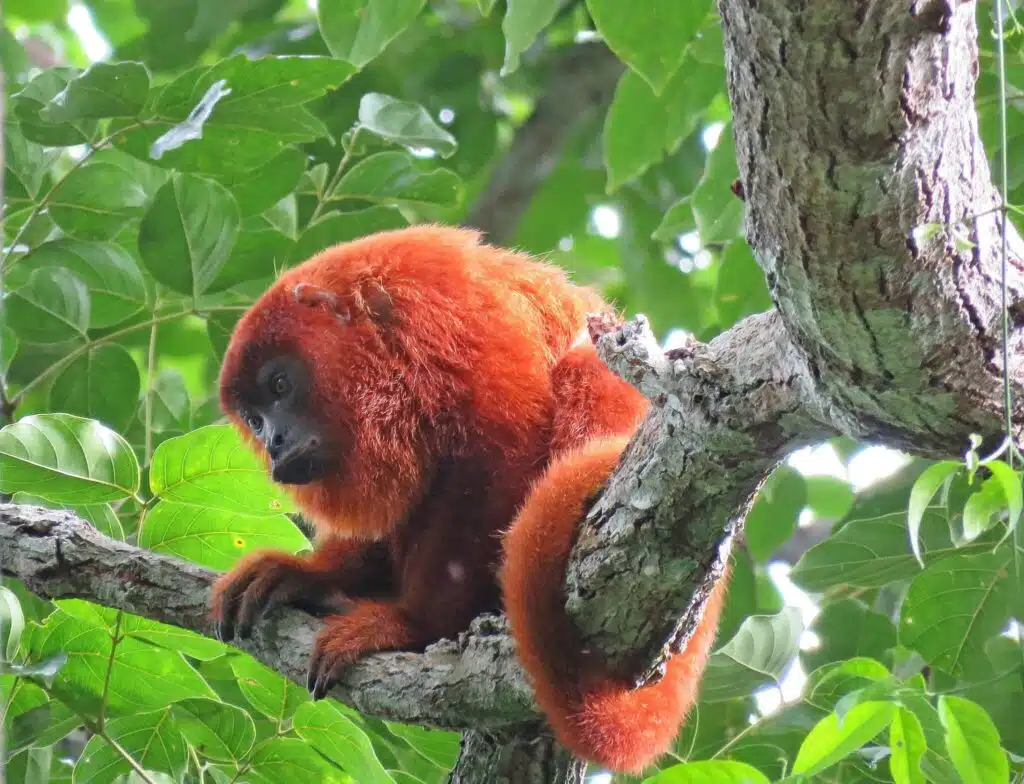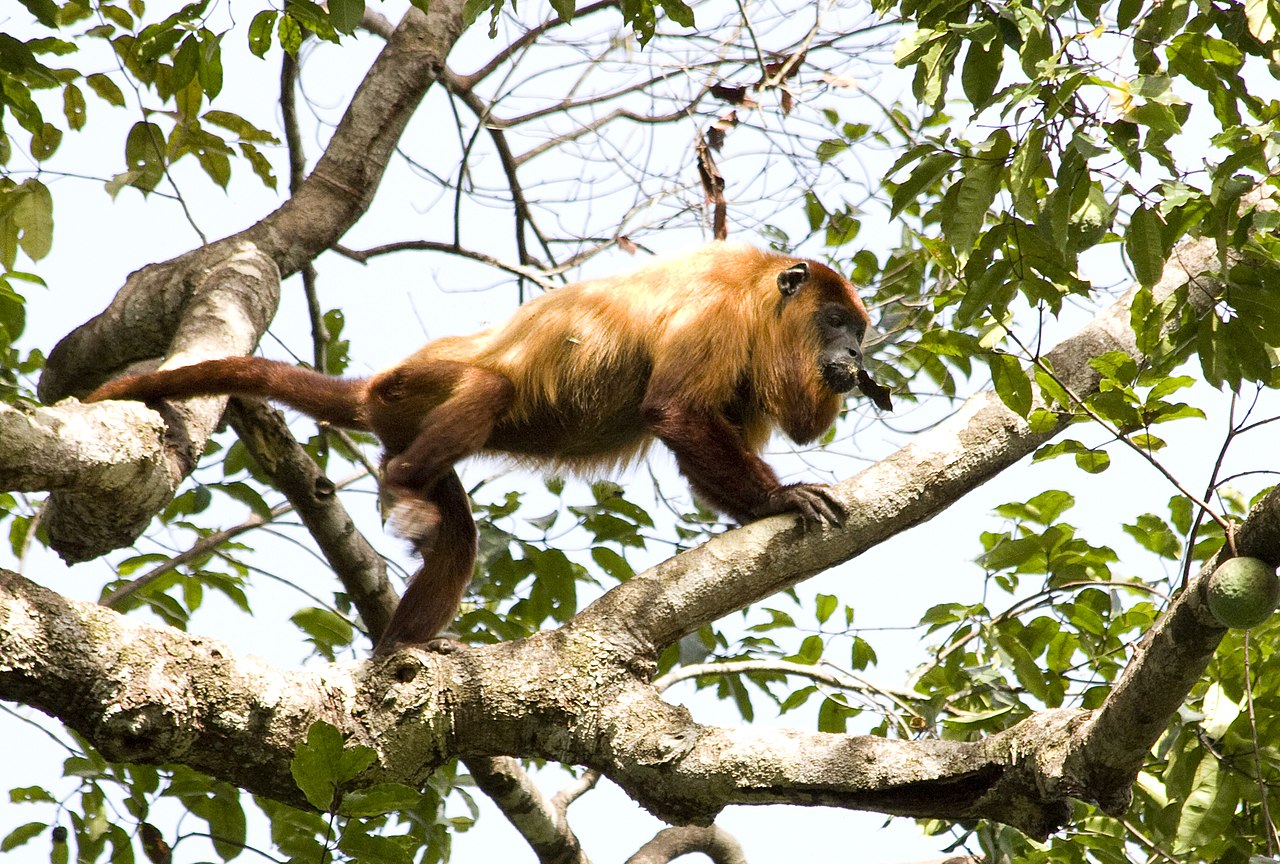Red monkeys are some of the most interesting in the world. Vivid coloring attracts attention, helps separate species, and may even indicate health levels in some species.
The Amazon, Africa, and forests in East or Southeast Asia are home to several species of red monkeys. Many of these monkeys are known for living long lives.
At the same time, the loss of habitat such as large-scale Amazon deforestation makes some red monkeys vulnerable and even species at the brink of extinction.
Here are some of the most representative red monkeys of the world with information on how they live in the wilderness.
Table of Contents
1. Colombian Red Howler Monkey

One of the larger and most common types of red monkeys is The Colombian Red Howler (Alouatta seniculus).
This species has a deep red nuance which is also slightly brown. Its brown undertones are mostly seen with age as the monkey darkens over time.
A social species, this monkey also possesses other distinguishing physical traits, such as having a wide or elongated jawbone.
Its social structure is based on communal living with up to 9 Colombian Red Howler Monkeys being part of a troop.
A species with a dominant male, the group is characterized by the alpha male breeding with all females.
Both males and females have red-brown coloring and darker red hairs on their long tails.
The roars of howls of the species are also a distinct feature, mostly based on their territoriality.
These monkeys are further known for their howls that keep others of their type away to avoid confrontation.
Living in Colombia, Ecuador, Peru, and Brazil, these red-nuanced monkeys may face adversity when males from other groups try to infiltrate an established troop.
2. Guianan Red Howler Monkey

Mostly red nuances are seen on these South American monkeys (Alouatta macconnelli), with brighter hairs specific to females.
Deep red hairs are specific to the males of the species. Both male and female hairs begin to darken after a few years.
The red nuance of the hairs itself can be an identification cue in establishing the approximate age of these monkeys.
Like other howler monkeys, they have a large jaw and a matching large neck which helps them howl or vocalize loudly.
A species that doesn’t like confrontation due to its low energy levels specific to low sugar diets, these monkeys prefer not to fight among themselves.
Living in troops, they number just a few individuals, typically up to 10.
Males live and breed with multiple females and vocalize as a means to keep others at a safe distance.
Males and females can enter groups, but not without a fight and not in a short period.
The males that want to enter troops have to fight the males within a group.
Stray females who want to enter a group also see a type of physical aggression from the other females in the group.
3. Bolivian Red Howler Monkey

Similar to The Colombian Red Howler Monkey, The Bolivian Red Howler (Alouatta sara) is seen as a distinct species.
Dark red hairs and red-brown hairs are mostly specific to this species. Brighter orange-red nuances are specific to its early days.
Along with its long life, this loud monkey also maintains its black bare-face appearance.
An arboreal species mostly eating leaves, Bolivian Red Howlers live in groups of up to 10 individuals.
One male is dominant but up to 2 other males may exist in a group. Up to 7 females may also live with the males in a troop.
A species that rarely climbs down from trees, The Bolivian Red Howler also uses its long red tail to move around trees.
Its habits include establishing territoriality, finding suitable leaves, and breeding with the multiple females of the group, typically under a certain hierarchy.
Its arboreal nature isn’t impacted by the heavy rain in the rainforest.
Even more, Bolivian Red Howlers may live in some of the most remote and flooded or swamp areas of the rainforest up on trees.
Native to Bolivia, they are also known for inhabiting higher-elevation forests compared to other red monkeys.
4. Western Red Colobus

Chestnut-red nuances are specific to the body of The Western Red Colobus (Piliocolobus badius). This species may also show black sections on its back and the top of its head.
Long hairs are seen on its body which may measure up to 30 inches with an additional 30-inch-long tail.
Western Red Colobuses and their 3 subspecies live across the West African coast.
Unlike other types of red howler monkeys, Western Red Colobuses live in large and very large groups, even if they now suffer from fragmented populations.
These types of monkeys show the tendency to live in groups of up to 80, with males and females separated by hierarchy.
Males are always outnumbered by females in a typical troop.
These monkeys are highly arboreal, spending their days and nights up on trees. Thickened skin on their bottoms allows them to do so comfortably and for a long period.
Living in large troops, these monkeys may sometimes become aggressive towards each other.
Some types of communication skills such as vocalization and learning face mimicry help them avoid confrontation.
Breeding rights are among the most important reasons for aggressiveness escalation.
On the other hand, it’s the higher-hierarchy female that chooses the male to breed with, also typically a higher-hierarchy male.
5. Red-mantle Saddle-back Tamarin

A red-brown nuance dominates the appearance of Red-mantled Saddle-back Tamarins (Saguinus lagonotus).
Black, yellow, and even orange sections are also seen on the back of these small black-headed monkeys.
By size alone, Red-mantle Saddle-back Tamarins are some of the smallest types of red monkeys. They may only grow to a maximum of 11 inches.
Living deep in the rainforest in the Western Amazon, this is a small species of red monkey also exposed to a higher number of potential predators.
Much of its life is spent avoiding predators by mostly living and moving around tree canopy.
Rarely seen on the ground, these monkeys are seen as prey for raptorial birds and snakes of The Amazon.
High levels of aggression are specific to these monkeys, as a means of survival and troop conservation.
They often fight other groups and even other species of monkeys.
Most times, on the other hand, troops are rather peaceful and may only be aggressive when their territories are under threat.
This species is also known for having a reduced lifespan compared to other red-haired monkeys as they only live up to 8-13 years.
6. Red Leaf Monkey

Bright red nuances and red-brown nuances dominate the long hairs of Red Leaf Monkeys (Presbytis rubicunda).
The species is always darker, even if its hairs become even darker as they age.
A Borneo native, Red Leaf Monkeys don’t only feed on leaves. Apart from your leaves, they also eat fruit and seeds.
Seasonality also plays an important role in their feeding habits. These monkeys eat leaves from October onwards, preferring seeds and fruit for the rest of the year.
Heavy rainfall isn’t rare on Bornean islands where they may be locally referred to as Maroon Monkeys.
These types of monkeys are also highly aggressive and territorial.
Part of their aggressiveness includes having loud vocalizations but they may also enter fights with other troops.
Male-to-male aggression is more specific, on the other hand.
The size of their troop also signals their aggression level as these monkeys may also live in very small groups of just several individuals.
7. White-tailed Titi

Red sections are specific to the fur on the neck, legs, and sideburns of The White-Tailed Titi (Plecturocebus discolor).
This is a species dominated by brown and white hairs across the body and its thick tail, on the other hand.
White sections are also specific to its forehead.
Fruits and leaves are part of its diet. Its dietary choices depend on its location in the forest.
Certain forest openings or edges favor extra ripe fruit and White-tailed Titis here mostly eat fruit.
These types of monkeys are also known to travel, albeit over short distances, and mostly for food or to become part of a group.
As they live in groups, these monkeys also travel in groups. They may intersect with other groups but try their best to avoid other troops.
Communal living is specific to these monkeys which may form family groups or live together with the offspring as part of larger groups.
Male and female White-tailed Titi monkeys are also known to form long-lasting relationships, only breeding among them for life.
8. Ornate Titi

Red patches are specific to Orante Titi monkeys (Plecturocebus ornatus). This is a species with red front legs, a red chest, and red sideburns and cheeks.
Brown and gray fur dominates their backs and their fur, in general.
These types of monkeys are highly social and communicative among them.
Males and females live together in harmony, as part of a group, with their offspring.
Each offspring remains with the group until a new one arrives before venturing out on its own.
Males of the species also show care habits towards their offspring. They carry and play with the young monkeys while their mothers only feed them.
Fathers and even adult monkeys, in general, are more playful than others. Juveniles and adult Ornate Titi monkeys often form close bonds, playing together when not feeding.
Vocalizations are used to keep various predators as well as other monkey groups away.
9. Golden Snub-nosed Monkey

Golden Snub-nosed Monkeys (Rhinopithecus roxellana) aren’t always red. They become red as they mature.
A golden orange-red nuance is mostly characteristic of an adult Golden Snub-nosed Monkey.
Eventually, their long hairs turn red and dark red as the monkeys age from a more brown-dominated appearance as juveniles.
Also known as The Sichuan Snub-nosed Monkey, this is a species that lives in temperate climates and higher elevations in East China.
The species is further known for its capacity to resist cool winters.
Golden Snub-noised Monkeys are among the few species that can live in areas with snowfall in the winter.
Specific adaptations to the populations in Han River Valley are seen for the species to live in this cool climate. For example, they can eat lichen during the periods without any other viable food options.
10. Madidi Titi

A species of Bolivia and Peru, Madidid Titi monkeys (Plecturocebus aureipalatii) are partly red.
Dark red nuances are specific to the hairs on their hands and feet. They also show dark red sections around the face.
These types of monkeys live in remote areas in their small groups and maintain their distance from other monkeys through frequent vocalizations.
Madidi Titi monkeys are further known for living in pairs for life. A male only breeds with one female for life.
Once offspring are born, they are cared for both by the male and by the female.
Fathers are responsible for carrying the young around, only passing the offspring to the mother for feeding.
This species survives in low numbers and this has led to its late discovery.
11. Bald Uakari

A bright red face and red-brown hair are specific to The Bald Uakari (Cacajao calvus). This is a species that shows high vulnerability through its highly diminished numbers.
Its appearance inspires its name. The bald crown of the species is red, as is the exposed skin of its face.
Reaching a size of up to 18 inches, this is a species with thick fur specific to Western Amazon areas in Brazil and Peru.
Their red vivid heads are not only a physical trait for humans to use to identify the species but also a trait females rely on when choosing a male partner.
Diseases such as malaria can make their faces and red heads become paler, which signals the monkey is not a good breeding prospect for others in their groups.
These types of monkeys spend their lives up on trees, particularly since they are mostly specific to areas of the rainforest that are seasonally flooded.